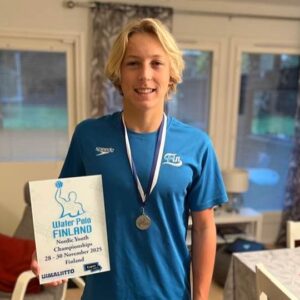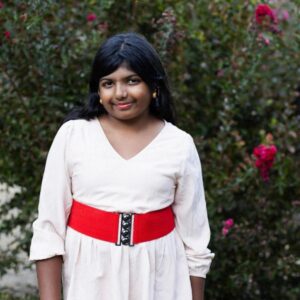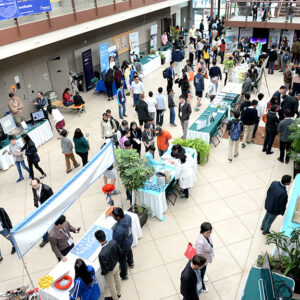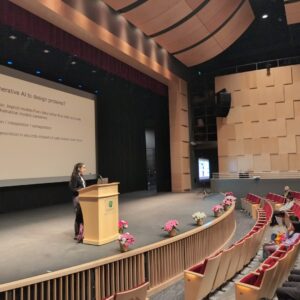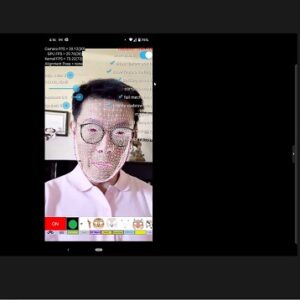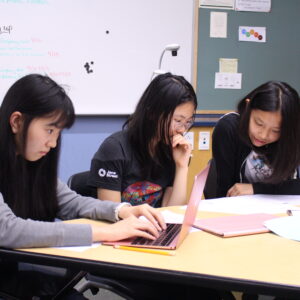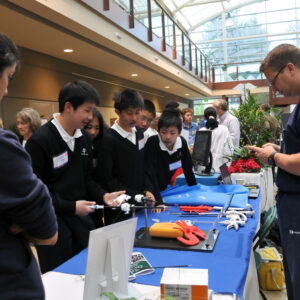The 13th annual Harker Research Symposium, held Saturday at the upper school campus, drew more than 700 people from the Harker community to learn more about “The Artificial Intelligence Revolution” – this year’s theme – and see the work of Harker student researchers.
Jeff Dean, a Google senior fellow with Google’s Brain Team and this year’s morning keynote speaker, attracted a large crowd to the Athletic Center for his talk on machine learning and how his team’s research has been applied to Google products. He also spoke about the ways machine learning will change how we live in the future, covering urban renewal through self-driving cars and better healthcare through improved informatics.
Attendees later made their way to the Nichols Hall atrium, where they perused the many exhibitors, including Microsoft, Nvidia, Roku and Solvvy, trying out virtual reality and holographic technology, as well as learning about advancements in video streaming and AI-driven customer self-service.
At the auxiliary gym, the middle and upper school poster presentations proved once again to be a popular attraction, as students gave detailed breakdowns of their research and findings to curious visitors. Breakout sessions also were held, during which Harker upper school students gave presentations on research projects they had conducted.
With artificial intelligence experiencing rapid growth, the symposium aimed to prepare future generations to enter (and perhaps have a hand in creating) a future of intelligent machines through a series of workshops for lower, middle and upper school students. In the upper school workshop, Harker parent and LodgIQ CTO Somnath Banerjee (Sumantra, grade 11, and Nila ’14) learned how to train neural networks and create a machine-learned image. Wayne Liu, general manager and vice president of business development at Perfect Corp., gave middle schoolers an introductory lesson on AI and how it is used in the real world, and got them started on an AI project of their own. Lower school students received a primer on AI and played games that taught key concepts in two separate workshops, one conducted by junior Natasha Maniar and sophomore Cynthia Chen, and another led by sophomores Joshua Valluru, Eileen Li and Vani Mohindra.
During lunch, attendees once again flocked to the quad to see chemistry teachers Andrew Irvine and David Casso (very safely) create balls of fire and spectacular plumes at the chemistry magic show, after which the crowd returned to the Athletic Center for the afternoon keynote address, delivered by Andrew Beck, co-founder and CEO of PathAI. In his talk, Beck detailed the work he is doing with PathAI, which aims to develop image recognition technology for use in pathology, including improving accuracy in the diagnosis and prediction of cancer. He also shared the impact he expects this technology will have on the medical field in the coming decades.
Alumna speaker Ramya Rangan ’12 delivered a talk on molecular machines to a packed Nichols Hall auditorium, detailing how discoveries about the inner workings of proteins and other macromolecules will lead to the design of human-made molecular machines, and the questions such advancements will bring.
Afternoon events also included talks by finalists from this year’s Siemens Competition and Regeneron Science Talent Search, with presentations given by senior Swapnil Garg and junior Katherine Tian, whose team project took them to national finals of the Siemens Competition, and seniors Justin Xie and Rajiv Movva, who were finalists in the Regeneron Science Talent Search.
The event closed with a panel discussion on the various research opportunities available to Harker students, delivered by upper school science teachers Anita Chetty and Chris Spenner, Harker parent Prasad Movva (Rajiv, grade 12, and Neil ’15), seniors Nastya Grebin, Amy Jin, Rajiv Movva and Justin Xie, and junior Katherine Tian.

